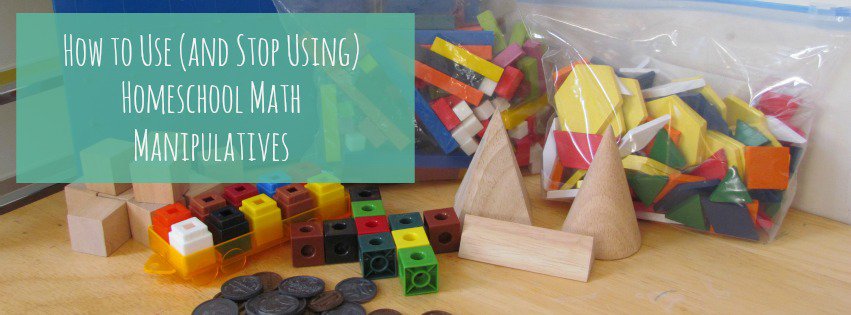3 steps to help your children get the most out of homeschool math manipulatives without becoming dependent on them.
The benefits of math manipulatives…and a caution
A friend glowed with pride as she told me how the AL abacus was helping addition “click” for her math-struggling daughter. But, she worried that her daughter would never stop using the abacus: “I don’t want her to have to carry an abacus in her purse to make change when she’s an adult!”
Math manipulatives are essential teaching tools. They transform the abstract language of math into something that kids can touch, see, and move around.
But my friend raised an important point. Math manipulatives can actually slow down children’s math development if they’re used too much. When children always use manipulatives, the concrete materials can become a crutch that prevents them from developing more sophisticated ways to solve problems.
Our big-picture goal in math is for kids to learn math so well that they can easily solve problems without manipulatives. Here’s how to gently help your child stop using manipulatives when he’s ready for more abstract problem-solving, with a video demonstration.
Three steps to avoid over-relying on manipulatives: hands on, hands off, and eyes closed
Step 1: Hands On
When you first introduce a concept or strategy to your child, you want your child to have his hands on the manipulatives. He should often touch and move the manipulatives as he grapples with the concept that you’re teaching.
Step 2: Hands Off
But once your child can easily and confidently solve problems with the manipulatives, let him set up the problem with manipulatives, but then take his hands off. Have him visualize moving the objects rather than physically touching them.
Step 3: Eyes Closed
When your child can solve problems without touching the manipulatives, encourage him to begin to visualize the manipulatives. Have him close his eyes and imagine moving the manipulatives around to solve the problem.
In this 3-minute video, you’ll see what the three steps look like in action when applied to simple addition.
Once your child can solve problems by visualizing manipulatives, he’s ready to solve problems with pencil and paper. Allow him to go back to the manipulatives if he really gets stuck or confused, but encourage him to visualize the manipulatives as much as possible. With some practice, he’ll rely on the visuals less and less as he solves problems.
Two things to keep in mind
First, note that people can typical only visualize five things unless the objects are organized in some way. That’s why I highly recommend using a ten-frame to organize the counters when you’re teaching the basic addition and subtraction facts. Any time you ask a child to visualize manipulatives, make sure to try it yourself first!
Second, there’s no need to rush this process. Some kids will need to work with concrete manipulatives for a long time before starting to visualize them, while others will move to the next stage more quickly. One of the wonderful benefits of homeschooling is that we can tailor our instruction to our child’s unique needs.
Teaching math doesn’t need to be complicated or expensive. Just a few well-chosen materials can help your child understand math deeply, especially when you use them well and keep them from becoming a crutch.
Happy Math!




Please subscribe me if I”m not already
I got you added, so you’re all set! Thanks!
Can you add me to any news and information that would be helpful? I’m homeschooling at first grade level with one child 🙂 I found this to be very helpful.
What do you suggest for children who can’t visualize the manipulative?
Ooh, that’s a great question, Sarah! That one definitely needs a whole post to answer. Are there any particular concepts where you’ve run into this with your kids?
I am also interested in this post if you have written one because we tried “visualizing” and her comment is “all I an see is black! I can only imagine unicorns and dolphins” lol
So cute! Instead of having her close her eyes, try just putting a blank ten-frame in front of her and having her imagine where the counters would be. (For example, for 4 plus 3, she could point to the 4th box and then the 7th box.) She may also be ready to try reasoning about the numbers. For example: “You know 3 plus 3 is 6. So, what’s 3 plus 4?” Most of all, be patient and trust that she’ll get those addition facts down to 10 before too long.
Happy Math!
Kate
I haven’t had any trouble with my kids yet. I can’t visualize images, so I would like to know how to keep up with them and teach them properly if they can, and learn how to help them if they can’t. I am looking forward to the post!
Ah, got it! Stay tuned. 🙂
Do you then not recommend programs like Right Start math? I recently purchased level A and B for my kids who were doing Christian Light math. My daughter seems to like it a lot better. I don’t know if I should have just stuck with CLE math or not. She has some sensory processing and auditory processing issues.
Hi Lana, No, not at all! (In fact, I highly recommend RightStart Math–check out my full review in the curriculum tab above.) Manipulatives are very useful for teaching kids to really understand the concepts of math.
What’s important is that kids translate the knowledge from the manipulatives into their heads, so that they don’t rely on the manipulatives, and RightStart actually does this very well. Kids gradually transition from using the abacus only, to using the abacus to solve written problems, to solving problems without the abacus.